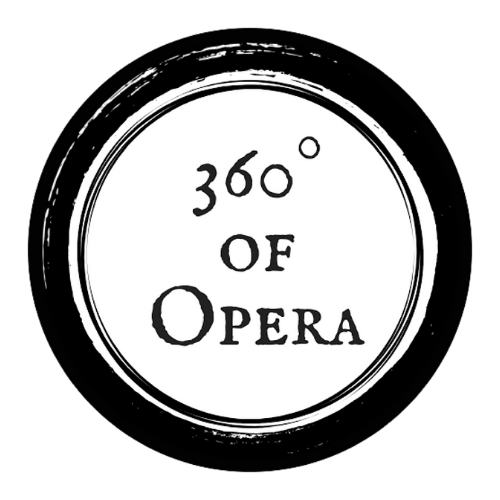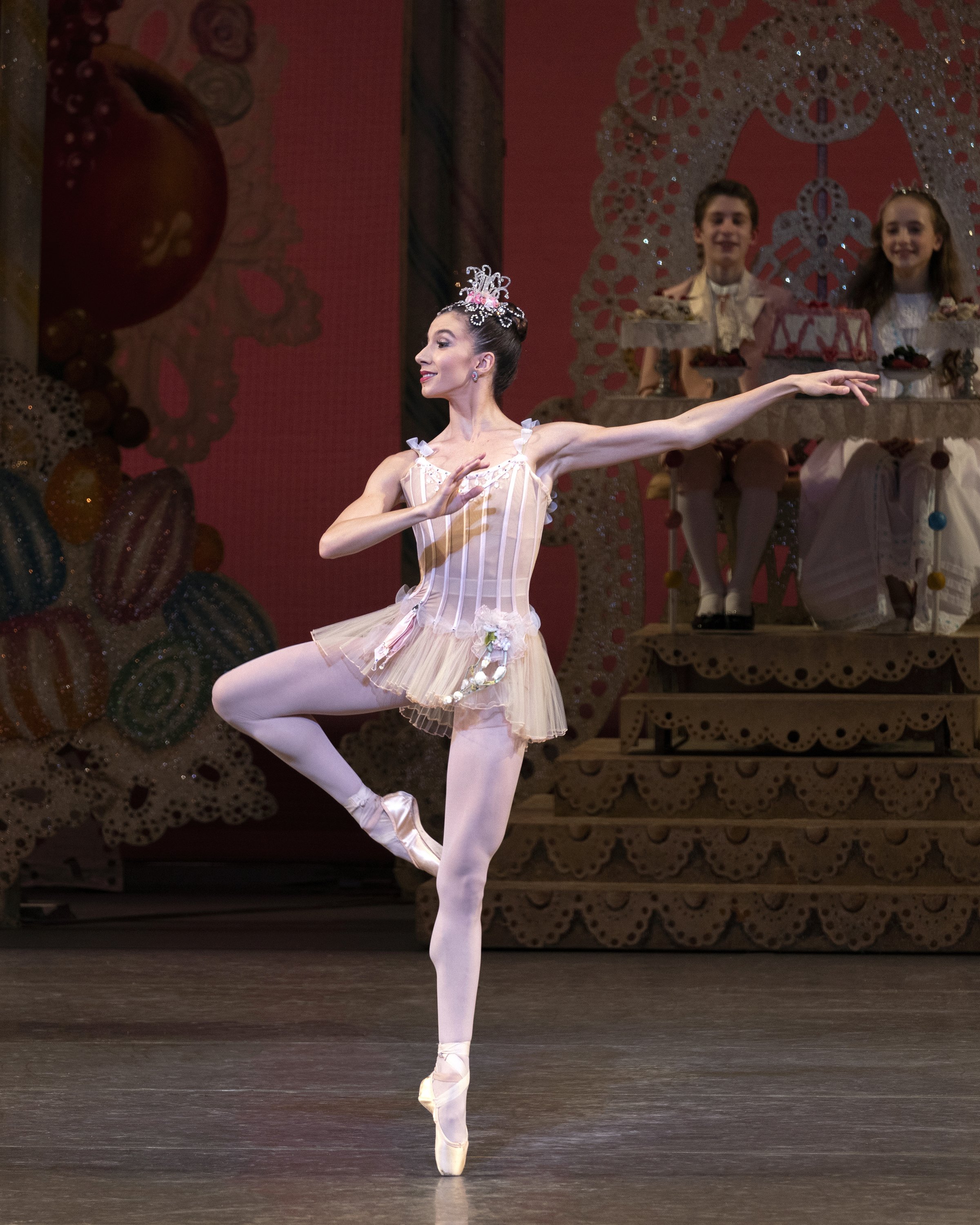NYC Ballet: The Nutcracker
The Company in New York City Ballet’s production of George Balanchine’s The Nutcracker. Photo credit: Erin Baiano
Written by Logan Martell.
December 5, 2023, saw the second press night of the New York City Ballet’s run of “The Nutcracker.” George Balanchine’s staging of this holiday classic continues to triumph in transporting audiences from the cozy, Christmas night of the Stahlbaum family to the enchanted world of snow and sweets.
Leading the orchestra in Tchaikovsky’s sumptuous score was conductor Andrews Sill, with Assistant Concertmaster Nicholas Danielson filling in for violin soloist Kurt Nikkanen.
First premiering in 1954, Balanchine’s “The Nutcracker” draws from his childhood experience as a student dancer in Petipa and Ivanov’s production in St. Petersburg. Rouben Ter-Arutunian’s scenery beautifully sets the stage, which unfolds much like a Christmas present as the frames of gold ornament and starry blues gradually pull away as the opening scenes progressed. Small but effective touches, like the translucent curtain to peer into the other rooms of the house at certain points, helped achieve a greater sense of the Stahlbaum house. Grander details, like the Christmas tree which rises from below to depict Marie’s shrinking, made for a splendid touch of magic.
Willow McConnaughy and students from the School of American Balletin New York City Ballet’s production of George Balanchine’s The Nutcracker. Photo credit: Erin Baiano
In the role of Marie and her brother Fritz were Willow McConnaughy and Nicholas Whipple, whose prowling natures saw them vie for the keyhole to peer into the party before the guests’ arrivals. Whipple frequently amused in Fritz’s antics, such as playing conductor to the band of drum and horn-playing children, and was met with laughter as he was repeatedly passed over for the ensuing march dance.
McConnaughy delighted as the focal character of the story, meeting these increasingly-magical encounters with wonder, excitement, and courage. When being introduced to Drosselmeier’s Nephew, the meeting of their hands would return as a motif to illustrate their growing love as the story continued, with each instance finding its proper mark. After the dances and festivities of the first scene, the battle against the mice, led by Preston Chamblee’s Mouse King, made for a charming bit of strife as McConnaughy found herself pointing orders to the soldiers before taking matters into her own hand.
As The Nutcracker, Theo Rochios excelled in the rigid, toy soldier-esque movements which disguised him as well as his costume after he snapped to life to battle the mice. Shortly after revealing himself as The Little Prince, he deftly navigated an articulate solo which recounted the events of being cursed by the Mouse King’s mother and led to victory by Marie.
As Herr Dosselmeir, guest artist Sean Suozzi provided a fine mystique through his use of his sweeping, black cloak, disguising himself as a hunched old man before revealing himself to the delighted Marie, or later as a pair of wings when he seemed to summon the mice from atop the grandfather clock. He seized the most of his time onstage and with intrigue and affection prepared some of the more fantastical elements which were to come.
Closing out the first act was the “Waltz of the Snowflakes,” which brought a splendid sense of natural beauty as the dancers flowed ethereally in and out of ornate groupings and arrangements, building along with the falling snow as if to pave the way to the Land of Sweet as Marie and her prince return to follow the star upstage and into another world.
Indiana Woodward in New York City Ballet’s production of George Balanchine’s The Nutcracker. Photo credit: Erin Baiano
In the role of the Sugar Plum Fairy, Indiana Woodward was a vision of elegance as she floated en pointe around the gliding angels, her ensuing solo featured refined piqué steps and flourishing port de bras with wand in hand as though casting a spell on her surroundings while backed by the running celeste. These qualities were showcased to ravishing effect for her final pas de deux with her cavalier, played by Anthony Huxley. Together they engaged in silk-like turns, as Woodward’s grace met with Huxley’s attentive support, able to create a sense of weightlessness as he helped her descend from her leaps or lifted her to proudly close out certain phrases. As she seemed to live in the maestoso rhythm, Woodward displayed great energy through her advancing series of pirouettes, as well as a touching delicacy through her demurriung cambré dips. After Huxley’s solo of grand pirouettes enough to make one’s head spin, the two came together to end with beauty as Woodward spun into her final cambré with poise and confidence as deep as her reach.
Indiana Woodward and Anthony Huxley in New York City Ballet’s production of George Balanchine’s The Nutcracker. Photo credit: Erin Baiano
Responsible for much of Act 2’s magic, the divertissements made for an enticing sampler of musical styles and dances. From the Spanish bolero-based rhythms of “Le Chocolat,” led by India Bradley and David Riccardo, we’re taken to the exotic atmosphere of “Le Café,” featuring Alexa Maxwell as the solo dancer with sultrier gestures and finger cymbals to accentuate her high steps and hand positions. “Le Thé” continued in this orientalist mood with Grace Scheffel and Quinn Starner letting loose Sebastian Villarini-Velez from his box to perform a series of leaps, spins, and aerial splits with explosive power and flexibility. “Candy Canes,” saw Daniel Ulbricht display his own acrobatic prowess through the tight, hooped leaps, while the Marzipan Shepherdesses led by Olivia MacKinnon brought things back to a more traditional feel with their controlled turns and legwork. Following the levity of Mother Ginger and her Polichinelles, the “Waltz of the Flowers” saw Ashley Hod’s Dewdrop emerge from the ensemble to lead with spritely energy through her exits and reentrances as the rest wove their patterns of florid arrangements with precision and grace to breathtaking effect, building towards a final tableaux to close out the series of assorted confections.
Ashley Hod in New York City Ballet’s production of George Balanchine’s The Nutcracker. Photo credit: Erin Baiano
Tuesday’s performance had no shortage of aural and visual treats, with the dancers of the NYCB embodying the story and taking it to magical heights. Balanchine’s choreography and staging bring out the most from Tchaikovsky’s work and turn it into a timeless fairy tale that is unapologetically beautiful. With these elements so at the forefront, it’s little wonder why this production has become so associated with the magic of Christmas, able to be enjoyed by audiences of all ages.
This holiday tradition will continue its run of performances until the winter season ends on December 31, 2023. The New York City Ballet will open their Winter 2024 season on January 23 with their “Tribute to Robbins” program as they celebrate the renowned choreographer.
Written by Logan Martell.






